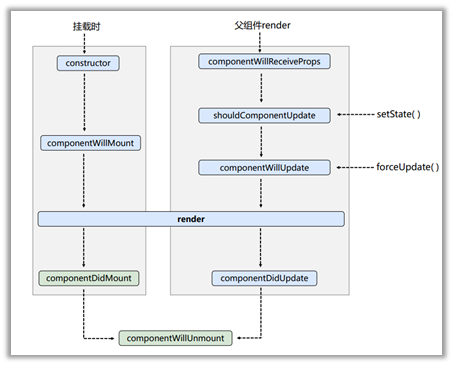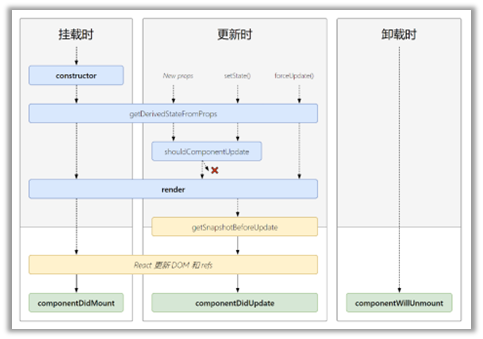对生命周期的理解
组件从创建到死亡它会经历一些特定的阶段。
React组件中包含一系列勾子函数(生命周期回调函数), 会在特定的时刻调用。
我们在定义组件时,会在特定的生命周期回调函数中,做特定的工作。
生命周期(旧)
生命周期流程图(旧)

生命周期的三个阶段(旧)
1
2
3
4
5
6
7
8
9
10
11
12
13
14
| 1. 初始化阶段: 由ReactDOM.render()触发---初次渲染
1. constructor()
2. componentWillMount()
3. render()
4. componentDidMount() =====> 常用
一般在这个钩子中做一些初始化的事,例如:开启定时器、发送网络请求、订阅消息
2. 更新阶段: 由组件内部this.setSate()或父组件render触发
1. shouldComponentUpdate()
2. componentWillUpdate()
3. render() =====> 必须使用的一个
4. componentDidUpdate()
3. 卸载组件: 由ReactDOM.unmountComponentAtNode()触发
1. componentWillUnmount() =====> 常用
一般在这个钩子中做一些收尾的事,例如:关闭定时器、取消订阅消息
|
案例
1
2
3
4
5
6
7
8
9
10
11
12
13
14
15
16
17
18
19
20
21
22
23
24
25
26
27
28
29
30
31
32
33
34
35
36
37
38
39
40
41
42
43
44
45
46
47
48
49
50
51
52
53
54
55
56
57
58
59
60
61
62
63
64
65
66
67
68
69
70
71
72
73
74
75
76
77
78
79
80
81
82
83
84
85
86
87
88
89
90
91
92
93
94
95
96
97
98
99
100
101
102
103
104
105
106
107
108
109
110
111
112
113
114
115
116
117
118
119
120
121
122
123
124
125
126
|
class Count extends React.Component{
constructor(props){
console.log('Count---constructor');
super(props)
this.state = {count:0}
}
add = ()=>{
const {count} = this.state
this.setState({count:count+1})
}
death = ()=>{
ReactDOM.unmountComponentAtNode(document.getElementById('test'))
}
force = ()=>{
this.forceUpdate()
}
componentWillMount(){
console.log('Count---componentWillMount');
}
componentDidMount(){
console.log('Count---componentDidMount');
}
componentWillUnmount(){
console.log('Count---componentWillUnmount');
}
shouldComponentUpdate(){
console.log('Count---shouldComponentUpdate');
return true
}
componentWillUpdate(){
console.log('Count---componentWillUpdate');
}
componentDidUpdate(){
console.log('Count---componentDidUpdate');
}
render(){
console.log('Count---render');
const {count} = this.state
return(
<div>
<h2>当前求和为:{count}</h2>
<button onClick={this.add}>点我+1</button>
<button onClick={this.death}>卸载组件</button>
<button onClick={this.force}>不更改任何状态中的数据,强制更新一下</button>
</div>
)
}
}
class A extends React.Component{
state = {carName:'奔驰'}
changeCar = ()=>{
this.setState({carName:'奥拓'})
}
render(){
return(
<div>
<div>我是A组件</div>
<button onClick={this.changeCar}>换车</button>
<B carName={this.state.carName}/>
</div>
)
}
}
class B extends React.Component{
componentWillReceiveProps(props){
console.log('B---componentWillReceiveProps',props);
}
shouldComponentUpdate(){
console.log('B---shouldComponentUpdate');
return true
}
componentWillUpdate(){
console.log('B---componentWillUpdate');
}
componentDidUpdate(){
console.log('B---componentDidUpdate');
}
render(){
console.log('B---render');
return(
<div>我是B组件,接收到的车是:{this.props.carName}</div>
)
}
}
ReactDOM.render(<Count/>,document.getElementById('test'))
|
生命周期(新)
生命周期流程图(新)

生命周期的三个阶段(新)
1
2
3
4
5
6
7
8
9
10
11
12
13
14
15
| 1. 初始化阶段: 由ReactDOM.render()触发---初次渲染
1. constructor()
2. getDerivedStateFromProps
3. render()
4. componentDidMount() =====> 常用
一般在这个钩子中做一些初始化的事,例如:开启定时器、发送网络请求、订阅消息
2. 更新阶段: 由组件内部this.setSate()或父组件重新render触发
1. getDerivedStateFromProps
2. shouldComponentUpdate()
3. render()
4. getSnapshotBeforeUpdate
5. componentDidUpdate()
3. 卸载组件: 由ReactDOM.unmountComponentAtNode()触发
1. componentWillUnmount() =====> 常用
一般在这个钩子中做一些收尾的事,例如:关闭定时器、取消订阅消息
|
案例
1
2
3
4
5
6
7
8
9
10
11
12
13
14
15
16
17
18
19
20
21
22
23
24
25
26
27
28
29
30
31
32
33
34
35
36
37
38
39
40
41
42
43
44
45
46
47
48
49
50
51
52
53
54
55
56
57
58
59
60
61
62
63
64
65
66
67
68
69
70
71
72
73
74
75
76
77
78
|
class Count extends React.Component{
constructor(props){
console.log('Count---constructor');
super(props)
this.state = {count:0}
}
add = ()=>{
const {count} = this.state
this.setState({count:count+1})
}
death = ()=>{
ReactDOM.unmountComponentAtNode(document.getElementById('test'))
}
force = ()=>{
this.forceUpdate()
}
static getDerivedStateFromProps(props,state){
console.log('getDerivedStateFromProps',props,state);
return null
}
getSnapshotBeforeUpdate(){
console.log('getSnapshotBeforeUpdate');
return 'atguigu'
}
componentDidMount(){
console.log('Count---componentDidMount');
}
componentWillUnmount(){
console.log('Count---componentWillUnmount');
}
shouldComponentUpdate(){
console.log('Count---shouldComponentUpdate');
return true
}
componentDidUpdate(preProps,preState,snapshotValue){
console.log('Count---componentDidUpdate',preProps,preState,snapshotValue);
}
render(){
console.log('Count---render');
const {count} = this.state
return(
<div>
<h2>当前求和为:{count}</h2>
<button onClick={this.add}>点我+1</button>
<button onClick={this.death}>卸载组件</button>
<button onClick={this.force}>不更改任何状态中的数据,强制更新一下</button>
</div>
)
}
}
ReactDOM.render(<Count count={199}/>,document.getElementById('test'))
|
getSnapShotBeforeUpdate的使用场景
1
2
3
4
5
6
7
8
9
10
11
12
13
14
15
16
17
18
19
20
21
22
23
24
25
26
27
28
29
30
31
32
33
34
35
36
| class NewsList extends React.Component{
state = {newsArr:[]}
componentDidMount(){
setInterval(() => {
const {newsArr} = this.state
const news = '新闻'+ (newsArr.length+1)
this.setState({newsArr:[news,...newsArr]})
}, 1000);
}
getSnapshotBeforeUpdate(){
return this.refs.list.scrollHeight
}
componentDidUpdate(preProps,preState,height){
this.refs.list.scrollTop += this.refs.list.scrollHeight - height
}
render(){
return(
<div className="list" ref="list">
{
this.state.newsArr.map((n,index)=>{
return <div key={index} className="news">{n}</div>
})
}
</div>
)
}
}
ReactDOM.render(<NewsList/>,document.getElementById('test'))
|
重要的钩子
render:初始化渲染或更新渲染调用
componentDidMount:开启监听, 发送ajax请求
componentWillUnmount:做一些收尾工作, 如: 清理定时器
即将废弃的钩子
componentWillMount
componentWillReceiveProps
componentWillUpdate
现在使用会出现警告,下一个大版本需要加上UNSAFE_前缀才能使用,以后可能会被彻底废弃,不建议使用。



